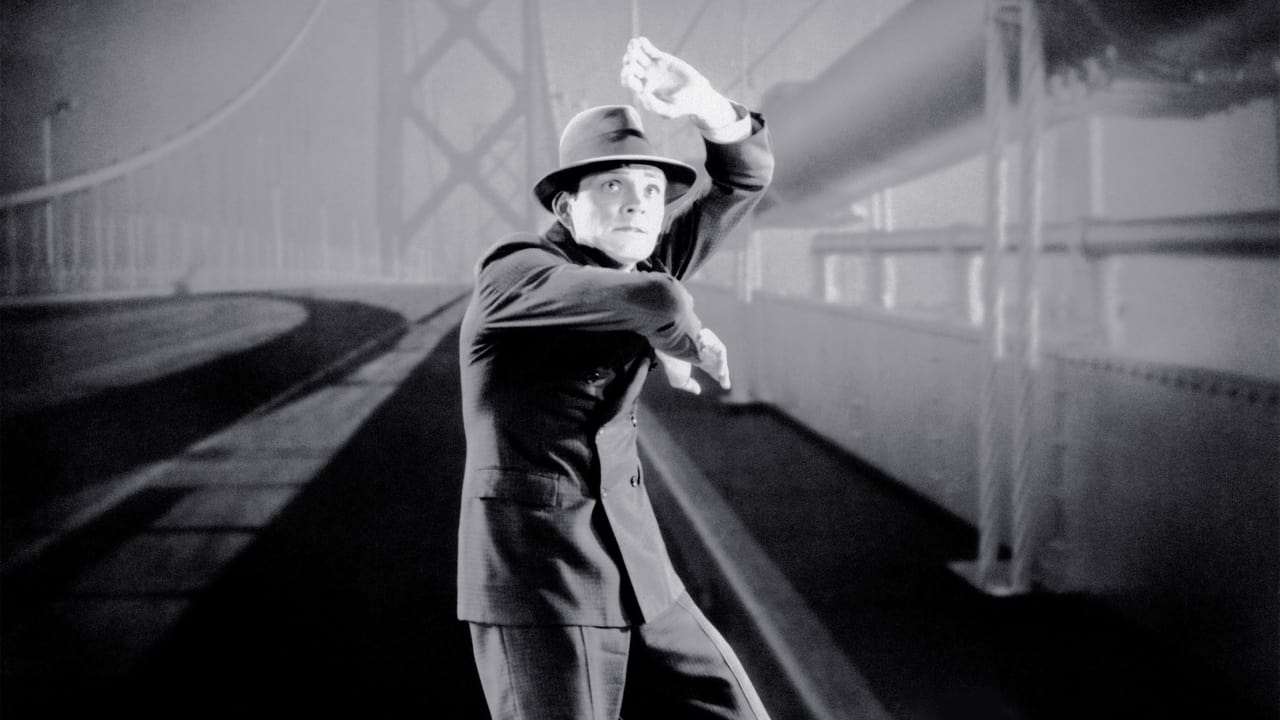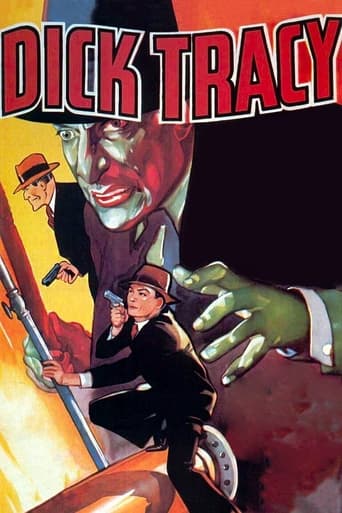


Best movie ever!
... View MoreA brilliant film that helped define a genre
... View MoreA Brilliant Conflict
... View MoreThis is a dark and sometimes deeply uncomfortable drama
... View MoreDirectors: RAY TAYLOR, ALAN JAMES. Screenplay: Barry Shioman, Winston Miller. Story: Morgan Cox, George Morgan. Based on the character characters created by Chester Gould. Photography: William Nobles and Edgar Lyons. Supervising film editor: Murray Seldeen. Film editors: Helene Turner, Edward Todd, William Witney. Art director: John Victor McKay. Set decorator: Morris Braun. Make-up: Bob Mark. 2nd unit director: William Witney. Music director: Harry Grey. Original music: Alberto Colombo. Special effects: John T. Coyle, Theodore Lydecker, Howard Lydecker. Process photography: Bud Thackery. Wardrobe master: Robert Ramsey. Wardrobe mistress: Elsie Horwitz. Production manager: Al Wilson. Script clerk: R.G. Springsteen. Sound recording: Terry Kellum, Daniel J. Bloomberg, Charles L. Lootens. RCA Sound System. Associate producer: J. Laurence Wickland. Producer: Nat Levine. Copyright 5 March 1937 (chapters 1-6) and 13 May 1937 (chapters 7- 15) by Republic Pictures Corporation. U.S. release: 20 February 1937. Each chapter consists of two reels, except for the first which has three. Total running time: 290 minutes.Chapter titles: (1) The Spider Strikes; (2) The Bridge of Terror; (3) The Fur Pirates; (4) Death Rides the Sky; (5) Brother Against Brother; (6) Dangerous Waters; (7) The Ghost Town Mystery; (8) Battle in the Clouds; (9) The Stratosphere Adventure; (10) The Gold Ship; (11) Harbor Pursuit; (12) The Trail of the Spider; (13) The Fire Trap; (14) The Devil in White; (15) Brothers United.SYNOPSIS: A notorious criminal, known as The Lame One or The Spider, kidnaps Dick Tracy's brother and turns him into a zombie who will obey the most fiendish orders without question, including the execution of his own brother!NOTES: Number five of Republic's 66 serials, filming commenced on 30 November 1936 and concluded on 24 December 1936. Negative cost: $127,640. Sequels: Dick Tracy Returns (1938), Dick Tracy's G-Men (1939), Dick Tracy vs. Crime, Inc. (1941). All three of these serials starred Ralph Byrd in the title role. COMMENT: One of Republic's most exciting and ingenious efforts, this solidly-made serial offers high-flying, non-stop entertainment from stop to finish, with only one exception. The economy chapter is number twelve. All the others are almost equally thrilling, combining an intriguing mystery element with super-fast action and stunts galore. There's little time for romance. Despite her billing, Kay Hughes has precious little to do. It's Fred Hamilton who makes a major contribution in each cliffhanger as Tracy's sidekick, with an assist from Smiley Burnette who offers a fair amount of comedy relief.Ralph Byrd is great in the role he was born to play. Also on hand is that glorious old trooper, Francis X. Bushman, who plays Tracy's boss, and Carleton Young who does a grand job in a role that actually amounts to chief heavy. (Fortunately, despite his elaborate introduction in Chapter One, Junior doesn't get into the line of fire too much and is not unduly in the way). The directors make absolutely brilliant use of their real locations including San Francisco's Oakland Bay Bridge and a disused power plant at San Pedro. And as for the Flying Wing, what a marvelous creation it is! Republic special effects wizardry at its zenith! Smart direction combined with impeccable photography and zestful film editing also deserve our unstinting applause. Each cliff- hanging dilemma presents us with a cleverly super-suspenseful fade- out too — except, of course, for that economy-conscious Chapter Twelve. In fact, (that dud twelfth episode notwithstanding) I would rate this entire serial as one of the Ten Best of All Time!
... View MoreONCE UPON A TIME, in 1931 to be exact, newspaper cartoonist, Chester Gould of the Chicago Tribune, presented his editor with a new concept for a comic strip. Rendered in a sort of early mechanical drawing style, populated with characters having names matching their physical characteristics and laden with an ever present, underlying supply of humor;it would be about a young man's career as a Detective on the Chicago Poice Department.THE TITLE THAT the young Mr. Gould had conjured up was "PLAINCLOTHES TRACY". The editor gave the subject a little thought and suggested that Gould ought to reconsider and change the first name to "Dick"; which was the nickname, even then, already well known for a Detective. With the surname of Tracy being suggestive of tracing a wanted subject, the two would be a perfect match.SO, THE COMIC strip was launched and DICK TRACY became an almost overnight success; soon being syndicated and appearing in hundreds of newspapers. With such success, it should be no surprise that Hollywood would soon be calling. It did and within the span of 6 short years, DICK TRACY was on the silver screen; now in the format of a 15 chapter Movie Serial, Cliff Hangere type.WE HAVE VIEWED the serial several times; some years ago. In fact, we do have video copies of all four of the Republic DICK TRACY Chapterplays. Today, Turner Classic Movies began a weekly presentation of the first one with the showing of Chapters 1-3. After the programing was over, many of our impressions and opinions surfaced once again.FIRST OF ALL, the casting of Ralph Byrd in the title role was a case of near perfection. Talented, athletic and possessing a very likable screen persona; Mr. Byrd was an immediate hit with the movie going public. What's more, he even bore a sort of real world resemblance to the Tracy of the print medium.THE SERIAL DID a fine job of bringing a great amount of action (the life blood of the movie serial); while at the same time taking the story to a great variety of locales. There appears to be as much time spent outdoors, as there is in studio sound-stages; which is always a plus in giving a picture a good, polished and luxurious appearance about it.THE CREATION OF a dark, menacing and sinister world is accomplished with the highest degree of success. The characterization of so many of the denizens who inhabit the shadowy underworld is a definite plus and serves to evoke the kind of mysterious horror as did so many of those great covers from so many pulp crime-mystery magazines of the 1920's-'40's.THE ONE ELEMENT that would become a hallmark for the Republic Serial, the greatest of special effects from Howard Lydecker (later joined by his brother, Theodore Lydecker) was present here. Mysterious rays, great explosions,realistic miniatures and a futuristic aeroplane; all add up to a fantastic, though believable world.ADDED TO ALL of that is the old Republic assembly line's creative use of stock footage, scenes from other productions and real life newsreel footage. Everything is blended almost flawlessly.ON THE DOWN side of things, unlike most of their future serials, there is no original musical score, but rather liberal doses of classical selections; including excerpts from Rossini's WILLIAM TELL OVERTURE and Lizst's LES PRELUDES.ALSO ON THE negative side of the ledger is Republic's habit of taking an existing feature (The Lone Ranger, Captain Marvel, Spy Smasher and especially Captain America) and radically changing it for the screen. In DICK TRACY and its 3 sequels, they make Tracy an F.B.I. Agent, exclude regular partner Pat Patton and make no mention of female lead and love interest in the comic pages, Tess Trueheart; who is Tracy's Fiancé!IN PLACE OF a regular detective partner, we are given a couple of hereto-for unknown commodities; including a comic relief buffoon portrayed by Smiley Burnette and a mysteriously vague version of Junior.
... View MoreSuperb serial. The only one that matches it in quality is the first Flash Gordon. The production values are exceptional and eclipse many better known B movies. Ralph Byrd is perfectly cast in the title role. The only explanation I can think of for some viewers to rate this any lower than an "A" is that they just haven't seen very many serials. One of the few efforts in this line that actually has some atmospheric touches and, as another commenter has pointed out, the special effects are genuinely good.Folks who don't really like serials are....well, they're folks who don't like serials (probably don't much like Christmas either). For those who do like serials, this is like a trip to the circus. Good action and WAY better than usual script and acting. As movies go, this probably only deserves a 7 but for a serial it deserves a perfect 10.
... View MoreDick Tracy is on the hunt of a mysterious criminal known as the Lame One ( he has a bum foot, but I think the title describes the villian's general appearance ), leader of the mysterious Spider Gang. The Lame One along with his hunchbacked assistant kidnap Tracy's brother, alters his appearance, and goes out fighting him endlessly throughout this boredom. This serial moves incredibly slow ( mainly this isn't a Whitney/English chapterplay ), the acting outside of Ralph Byrd is dead wood, especially Smiley Burnette. Even when the master criminal is unmasked, the audience is forced to say, Who was this guy. Add a really dumb, sentimental ending, and well you get the pic. Don't judge the next three serials based on this one. In terms of serials, 4 out of 10.
... View More